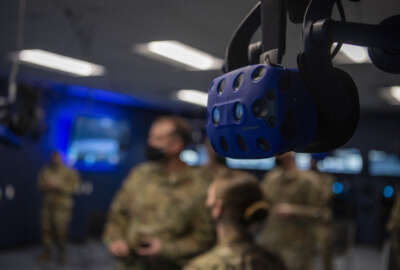

Students will wear goggles that allow them to mix chemicals without the dangers.
Best listening experience is on Chrome, Firefox or Safari. Subscribe to Federal Drive’s daily audio interviews on Apple Podcasts or PodcastOne.
The military has employed mixed reality technologies to better its training for the past few years, but now military schools are hoping to do the same thing when giving students a hands-on learning experience.
The Air Force Academy is changing the way students work with different substances in introduction chemistry classes by using mixed and extended reality goggles.
“The mixed reality headset creates a paradigm where you can see all the people around you in the real world and then you superimpose content into that world. So using holographic content, we can simulate the components that you would need to put together a chemistry laboratory experiment,” David King Lassman, CEO of GIGXR , the company providing the technology, told Federal News Network. “We think in the post COVID-world, there still may be instances of socially distanced learning, remote learning. This will allow students to participate in an instructor-led lesson using their mobile phones and tablets as conduits onto the content.”
The chemicals show up in a 3D space above the device, and allow students to mix chemicals and see reactions without the prospect of spilling dangerous substances on their bedroom carpet.
“These immersive experiences allow you to play around and fail,” said Air Force Academy Chemistry Assistant Professor Capt. Wale Lawal. “It’s kind of the safe space where you can fail, as opposed to what we have to do in class where we say ‘Here’s a recipe, here’s a chemistry experiment.’”
Lawal said students are able to repeat exercises they didn’t understand and try different chemical variables to fully grasp concepts.
“We can’t do that in reality, but in this type of technology, it affords us an opportunity to let our students think critically,” Lawal said. “That’s what we were really hoping to bring to the table with this new partnership.”
Lawal said he hopes the new technologies will excite more students into joining STEM programs, especially at a time when the Defense Department is actively trying to recruit more STEM-minded people.
“We’ve set up this Institute for Future Conflict, where we think about questions like ‘How are we going to prepare ourselves to understand new technology? How are we going to develop leaders who are innovative? How to bring together technical solutions that’ll solve today’s and tomorrow’s challenges,” Lawal said. “In every facet, we’ve been really trying to identify ways to bring people toward the STEM community, because it does, in fact, create that kind of engineering systems, engineering design thinking that you’re really going to need to solve tomorrow’s challenges.”
GIGXR is currently in a Phase II Small Business Innovative Research Contract for the HoloChem. It will use Microsoft’s Hololens 2 to allow students to see the virtual reality. The plan is to deliver the coursework in early 2022.
“We haven’t had much previous engagement with the Department of Defense at all and the process was pretty seamless and pretty straightforward,” said Lassman. “It’s great because it allows companies like ours that employ incredible innovators to take these investment dollars and really push the boundaries of what’s capable with these cutting edge technologies.”
Copyright © 2025 Federal News Network. All rights reserved. This website is not intended for users located within the European Economic Area.
Scott Maucione is a defense reporter for Federal News Network and reports on human capital, workforce and the Defense Department at-large.
Follow @smaucioneWFED


